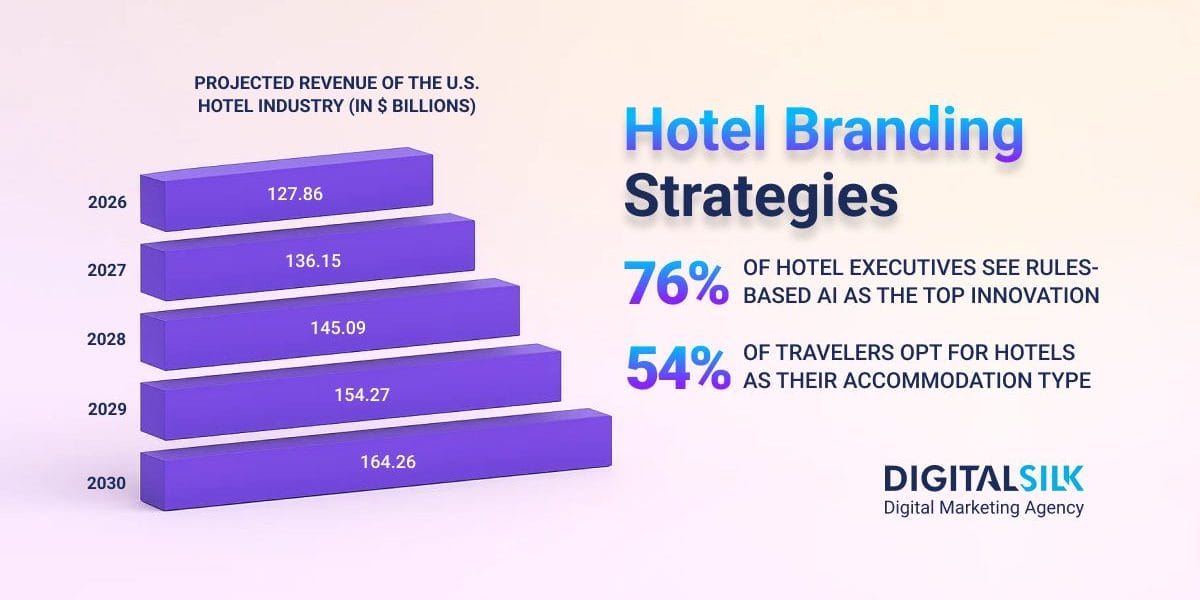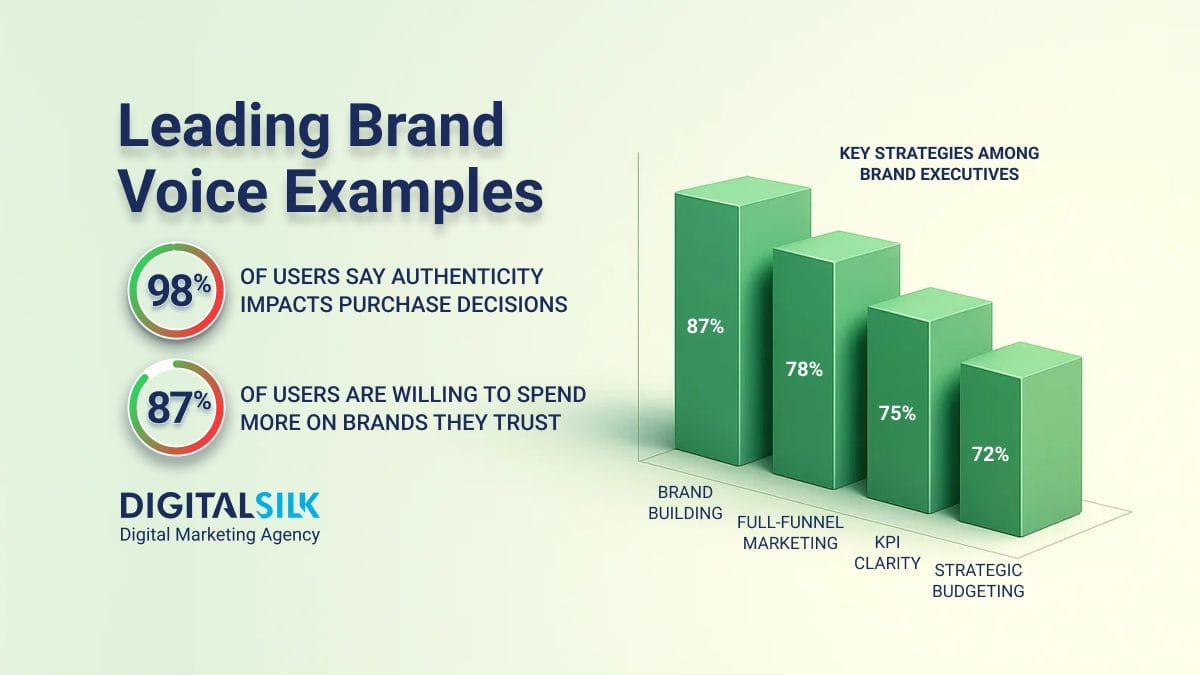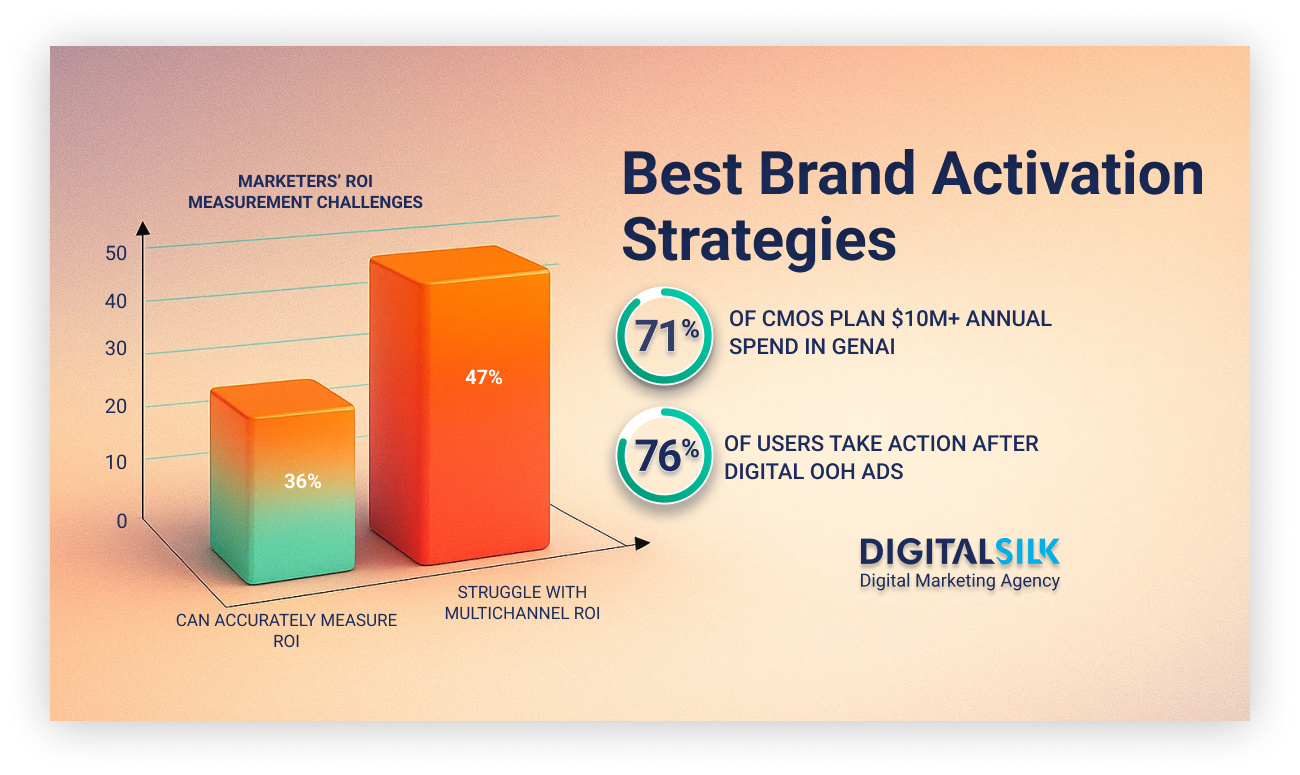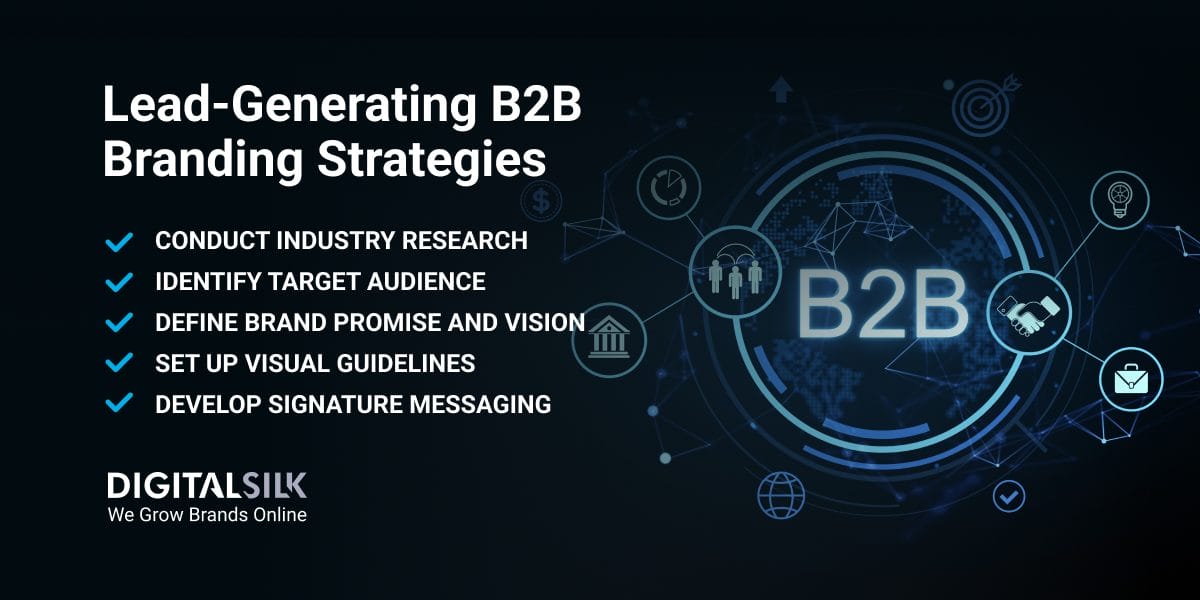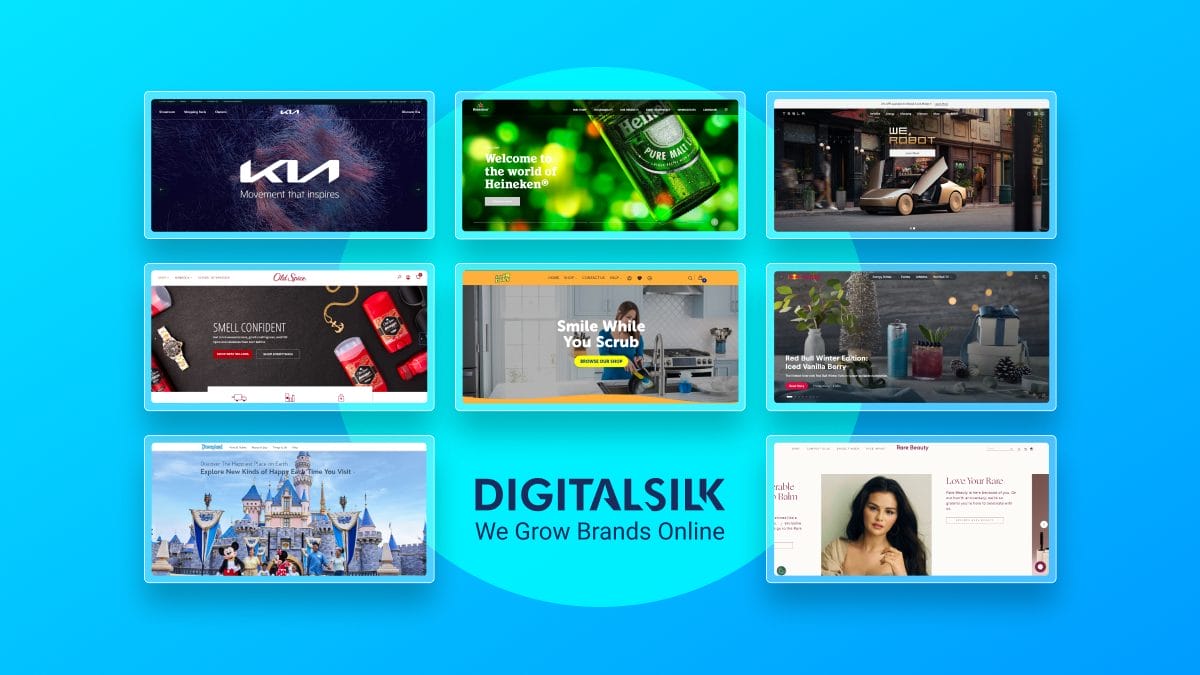Hotel Branding Strategies: Key Highlights
-
Identity in every detail: Ensure visuals, logos and design elements consistently communicate your hotel’s story and service level across all touchpoints.
-
Stories build memory: Use brand storytelling to connect with guests on an emotional level, weaving history, culture and purpose into a narrative they want to share.
-
Voice creates connection: Develop a brand voice that reflects your hotel’s personality, shaping trust and authenticity in every interaction from marketing to guest service.
Competition in hospitality has shifted. Guests are comparing rates but also brands.
The U.S. hotel industry is projected to generate $164.26 billion by 2030, but much of that revenue will concentrate among hotels with distinct, memorable brands.
A hotel branding strategy is about how guests perceive your property before they arrive, how they experience it during their stay and how they remember it afterwards.
In this guide, we’ll cover 13 advanced hotel branding strategies alongside hotel rebranding tips, examples of successful hospitality branding strategies and insights into resort branding strategies.
You’ll also see what separates strong brands from forgettable ones and how to position your hotel for long-term loyalty and growth.
13 Hotel Branding Strategies For Market Differentiation
A hotel brand strategy shapes how your property is perceived defines the kind of experience guests expect before they even arrive.
The 13 strategies below focus on differentiation frameworks that can help you strengthen market presence and capture valuable leads.
1. Define A Unique Value Proposition
A hospitality branding strategy starts with a unique value proposition that gives travelers a reason to choose your property before they compare rates.
With 54% of U.S. travelers selecting hotels when they travel, the competition for preference is intense and a vague promise of comfort or convenience will never set a brand apart.
A well-defined value proposition ties directly to the experiences and outcomes guests care about most, becoming the foundation for industry dominance, loyalty and long-term differentiation.
How to shape a compelling value proposition:
- Pinpoint the guest segment you most want to attract and uncover the pain points that other brands in your market ignore
- Craft a brand promise that is specific and measurable and tie it directly to the experience you can consistently deliver
- Test your proposition against competitors to ensure it stands apart in ways that cannot be easily replicated
- Embed the promise across operations, service and partnerships so it is reinforced beyond marketing
Among hotel branding examples in the U.S., EVEN Hotels demonstrates how a brand can build its identity around wellness and position the stay as an extension of a healthy lifestyle.
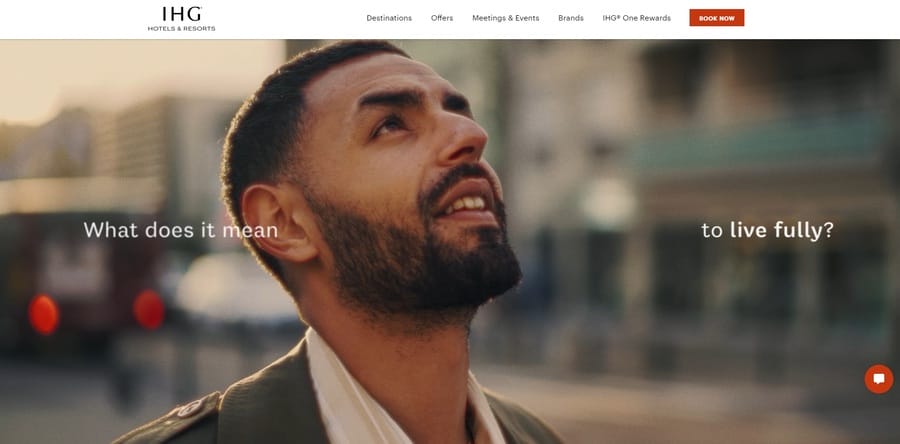
From in-room fitness zones to balanced dining options and wellness programming, the brand delivers a consistent promise that appeals to travelers who want to maintain their routines on the road.
This focus has helped it differentiate in the midscale market and build loyalty with health-minded guests.
2. Build A Clear Brand Identity & Visuals
55% of a brand’s first impressions come from visual elements, which means design choices often determine whether a guest decides to book or keep searching.
In hospitality, every logo, color scheme and photo sets an expectation about service level and experience, shaping both confidence in the brand and willingness to pay.
A clear brand identity ensures those signals remain consistent across spaces, channels and campaigns, turning design into a foundation for recognition and trust.
When visuals are aligned with the broader story, they create memorability that strengthens loyalty over time.
How to strengthen brand identity and visuals:
- Audit every visual element against your positioning to confirm it conveys the right signals about experience, service level and audience fit
- Create a unified design system so marketing, property teams and partners all work from the same visual framework
- Invest in photography and video assets that reflect reality to set expectations accurately and avoid guest disappointment
- Test visual assets with target audiences to uncover how design choices influence perception, preference and intent to book
For instance, The Cosmopolitan of Las Vegas positioned itself as the hotel for guests who want bold energy and curated indulgence rather than a traditional resort feel.
Its “Just the Right Amount of Wrong” campaign became a defining signal of its identity, pairing playful irreverence with luxury experiences.
By weaving that message consistently through marketing, entertainment and guest touchpoints, the brand turned itself into a lifestyle destination with lasting recognition.
3. Brand The Guest Experience
80% of customers say the experience a company provides matters as much as its products and services, which means a brand earns its meaning through the way guests live it each day.
Every detail, from how staff communicate to the way amenities are presented, either reinforces or weakens the story you want to tell.
Signature hotel brand standards turn service, design and rituals into signals that guests recognize and remember, building a connection that advertising alone can’t create.
Ways to bring the brand into the guest experience:
- Map guest touchpoints across the journey and define what emotions or signals the brand should deliver at each stage, from booking to post-stay follow-up
- Design service rituals that reflect brand values, so all interactions feel distinctive rather than interchangeable with competitors
- Extend branding into sensory cues like scent, sound or menu design, creating experiences that trigger memory and recognition
- Create hotel brand standards that guide staff behavior so the way guests are greeted, informed and supported consistently reflects the brand promise
For instance, The Ritz-Carlton defines its brand through the Gold Standards, which serve as the foundation of how the company operates.
At the center is The Credo, a declaration that the genuine care and comfort of guests is the highest mission.
It promises the finest personal service and facilities in a warm, relaxed yet refined atmosphere, with the goal of enlivening the senses, instilling well-being and fulfilling even unexpressed needs.
4. Tell A Compelling Brand Story
Stories shape how people connect with brands and influence the choices they make.
92% of consumers say they prefer advertisements that feel more like stories, which highlights the role narrative plays in building preference and trust.
A brand story gives meaning to the guest experience by weaving together history, values and vision into something guests can relate to and share.
You can strengthen storytelling by focusing on the following practices:
- Define the origin and purpose of the brand and connect it to a larger idea that guests can easily understand and value
- Use consistent themes across marketing, design and guest communication so the story feels cohesive at every stage of the journey
- Highlight people and experiences rather than features to make the story human and memorable
- Incorporate local culture or unique brand elements into storytelling to differentiate from competitors and create depth
For instance, The Algonquin Hotel in New York City is defined by its literary heritage.
Immortalized as the gathering place of the Round Table in the 1920s, it became synonymous with wit, creativity and cultural exchange.
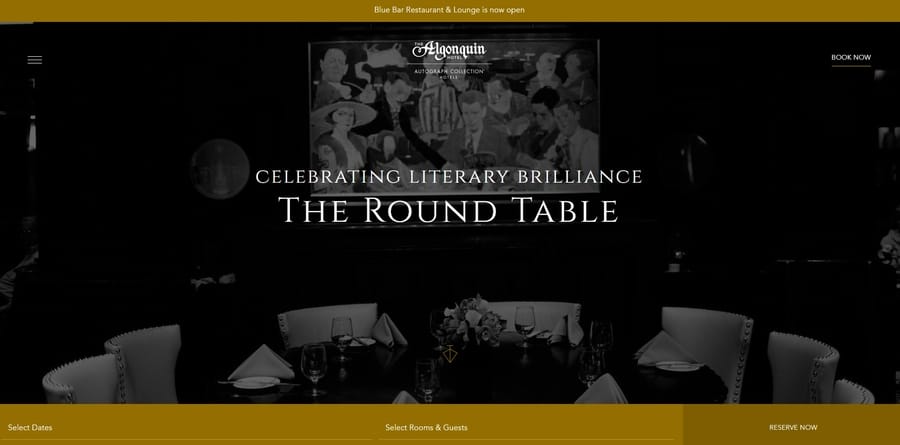
Today, the hotel carries that legacy forward with themed suites dedicated to celebrated writers, giving guests a chance to connect with a tradition that blends history and hospitality.
5. Develop A Memorable Brand Voice
In a market where every property promises comfort and service, the words a hotel uses can be the deciding factor in how guests connect.
With 98% of consumers saying authenticity influences their buying decisions, tone and language are no longer cosmetic choices but core elements in the branding strategy of hotels.
A distinct voice shapes expectation, builds trust and signals whether the experience will feel playful, refined or approachable.
How to develop a memorable brand voice:
- Define the personality traits that represent your brand and translate them into a tone that feels genuine in every interaction
- Create practical guidelines with examples of preferred language so voice remains consistent across marketing, reservations and guest communication
- Adapt tone to different contexts without losing identity, so a campaign, a confirmation email and a service script all feel connected
- Test voice directly with target audiences to confirm it resonates as authentic and reinforces trust in the booking decision
Moxy Hotels is one of the leading hotel branding examples that proves how voice can shape perception as much as design.
Its playful and irreverent tone runs through everything from cheeky ad copy to witty in-room signage, creating a sense of energy and connection.
The approach makes guests feel part of a community rather than just booking a stay, helping Moxy stand out in a crowded midscale market.
6. Design Signature Brand Touchpoints
Brands are remembered through the moments that consistently reinforce who they are.
In a hotel branding strategy, touchpoints act as living expressions of the brand promise, shaping how guests interpret and remember the experience.
From contact cards and key holders to menus, signage and other branded materials, each touchpoint should consistently communicate the identity and values of the hotel.
When thoughtfully designed, they become cues of identity that set expectations, deepen recognition and create memories that last well beyond the stay.
How to design signature brand touchpoints:
- Define which guest interactions best represent the brand promise and design them to consistently signal brand values rather than generic hospitality
- Develop branded materials and design elements such as menus, signage or printed cards that instantly connect back to the hotel identity
- Establish brand voice guidelines for communication so the language used in emails, marketing and face-to-face interactions reflects the same personality and values
- Document these standards in a dedicated brand book to ensure each property delivers the same recognizable touchpoints without losing authenticity
Four Seasons reinforces its brand through curated details that signal refinement in both design and service.
Branded water bottles, towels and other touchpoints reflect the same promise of comfort and care across properties.
These elements transform practical items into recognizable brand signatures that strengthen loyalty and set expectations before a guest even interacts with staff.
7. Build Strategic Brand Partnerships
Partnerships amplify a brand’s influence when they align directly with long-term positioning.
In the context of hotel and resort branding strategies, collaborations with like-minded brands extend reach, strengthen identity and create experiences that feel more meaningful to guests.
Whether it is a co-branded amenity, a retail tie-in or an exclusive cultural partnership, the right alliances reinforce what the hotel stands for while opening the door to new audiences.
Follow these principles for building strong brand partnerships:
- Identify brands with shared values and complementary audiences so collaborations feel authentic and strengthen brand perception
- Design co-branded experiences that highlight differentiation such as signature amenities, limited offerings or curated events tied to the hotel identity
- Use partnerships as storytelling opportunities by weaving them into marketing and guest touchpoints rather than treating them as stand-alone promotions
- Measure the impact of partnerships against brand objectives including guest perception, loyalty and market visibility to ensure they add long-term value
For example, Baccarat Hotel & Residences New York extended its identity through a partnership with La Mer, creating Spa La Mer within the property.
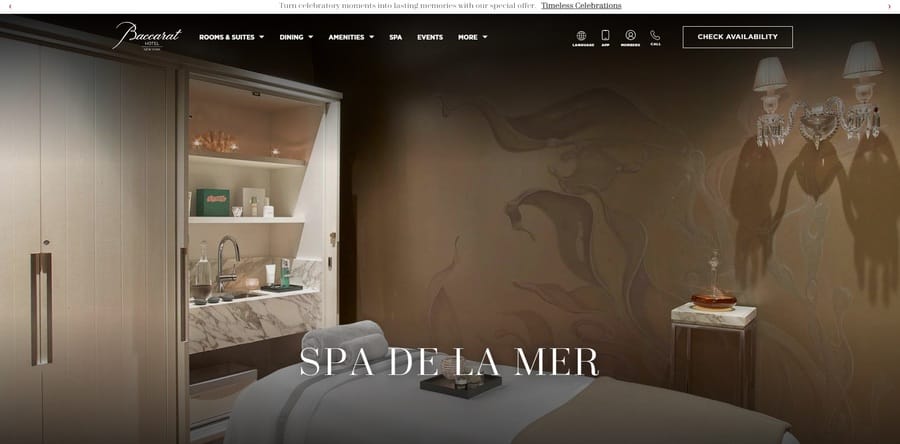
The collaboration aligned two luxury brands known for exclusivity and refinement, turning skincare into part of the hotel experience.
This type of partnership shows how hotel and resort branding strategies can deepen brand perception by bringing in complementary names that reinforce prestige and attract high-value guests.
8. Evolve Branding Through Innovation
Brand relevance depends on the ability to adapt and innovation provides the fuel for that evolution.
76% of hotel chain executives pointed to rules-based artificial intelligence tools, such as process automation and recommendation engines, as the areas where the most innovation will emerge in the next two years.
For hotels, this signals a need to rethink branding not just as design or messaging, but as a system that can integrate new technologies to shape perception, personalization and loyalty at scale.
When innovation aligns with brand identity, it strengthens differentiation and positions the hotel to capture opportunities before competitors.
Ways to evolve branding through innovation:
- Adopt new technologies that reinforce the brand promise such as AI-driven personalization that reflects service values
- Experiment with branded digital touchpoints like apps, chat interfaces or loyalty platforms that carry the same tone and visual identity as on-property experiences
- Collaborate with technology partners strategically to introduce innovations that deepen the brand story rather than dilute it
- Measure innovation through the lens of brand outcomes by tracking how changes impact recognition, loyalty and guest preference
9. Prioritize Customer Personalization
In the next three years, 51.5% of hospitality executives plan to use AI and analytics to deliver personalized marketing and offers, showing how quickly customization is moving to the center of the industry.
For branding, this is less about tools and more about creating experiences that feel designed for the individual while staying true to the brand’s identity.
When personalization is woven into communication, service and loyalty programs, it signals recognition, builds trust and makes the brand more memorable.
Ways to prioritize customer personalization in branding:
- Use guest data responsibly to design offers and experiences that reflect brand values rather than generic promotions
- Adapt digital channels to deliver tailored messaging so websites, apps and pre-stay emails consistently express the brand’s personality
- Bring personalization into on-property service by aligning recommendations and interactions with the brand’s tone and character
- Evaluate personalization through brand outcomes by tracking how it influences recognition, guest trust and preference over time
10. Introduce Hotel Loyalty Programs
Rewards shape how travelers perceive value, with 61.58% of people saying they want hotel stays to yield higher reward earnings.
That expectation puts loyalty programs at the center of booking decisions, influencing whether a guest returns or looks elsewhere.
When a program reflects the hotel’s identity instead of relying on generic points systems, it reinforces the brand story and creates attachment that extends beyond a single stay.
Structured with consistency, loyalty becomes an experience guests associate directly with the brand itself.
Ways to introduce loyalty programs that strengthen your brand image:
- Design rewards that mirror the brand promise whether that is luxury upgrades, wellness experiences or community-driven perks
- Use branded materials and touchpoints within the program so membership cards, apps and communication carry the same identity as the property
- Communicate loyalty benefits in the brand’s voice to make every offer feel consistent with how the hotel presents itself
- Differentiate through experiential rewards that tie back to what makes the brand distinctive rather than relying solely on discounts
11. Use Social Media Branding
With 81% of brands using social media to generate exposure, the opportunity lies in designing content that makes the brand memorable and builds trust over time.
The most popular hotel accounts create anticipation by sharing experiences guests want to be part of and by tying digital storytelling directly to what the brand represents offline.
This ensures social channels become extensions of the brand experience rather than isolated campaigns.
Hotel brand marketing tips for stronger social media branding:
- Highlight brand-defining experiences through content whether it is dining, events or service rituals that express identity
- Collaborate with creators or partners who align with the brand so partnerships feel authentic and expand reach
- Use interactive formats such as polls, Q&A or behind-the-scenes posts to create engagement that strengthens the brand narrative
- Track impact through brand-focused metrics such as awareness lift, share of voice and booking influence rather than vanity numbers
Take CitizenM as an example, which uses a strategy that leans into wit and self-awareness as part of its brand identity.
Instead of ignoring critical reviews, the brand reframes them with humor, as seen in posts where comments about compact rooms or weird designs are turned into playful content that highlights the efficiency and design of the space.
This approach shows how hotels can use social platforms not just for exposure but as brand storytelling tools, turning guest perceptions into assets that reinforce personality and memorability.
12. Optimize Reputation Management
Reputation drives purchasing behavior, with 86% of U.S. consumers considering it highly important when making decisions.
For hotels, reputation takes shape publicly, influenced daily by reviews, guest feedback and digital mentions that carry significant weight in how the brand is perceived.
Reputation management is not just about resolving issues after they appear but about shaping a consistent narrative that reinforces trust and reflects the brand’s values.
How to approach reputation management as part of branding:
- Respond quickly and consistently to reviews across all platforms, showing attentiveness while keeping the tone aligned with brand voice
- Centralize monitoring of reviews and mentions to ensure nothing is overlooked and feedback is managed cohesively
- Personalize responses within structured guidelines so replies feel authentic while still protecting the integrity of the brand
- Collect and act on feedback during the guest stay to resolve concerns before they appear in public reviews
- Audit brand presence regularly across digital platforms to confirm consistency of tone, messaging and identity
13. Track And Analyze Performance
Strong branding is only as effective as the results it generates and measuring those results requires more than surface-level numbers.
In travel, the average conversion rate is 2.4%, slightly lower than the global average but still a useful benchmark for evaluating performance.
Tracking the right metrics allows hotels to see how brand investments influence bookings, guest loyalty and overall profitability.
Without this visibility, it becomes difficult to refine strategy, allocate resources or identify which parts of the brand story resonate most with guests.
Use these steps to track and analyze brand performance:
- Monitor website conversion rates against industry benchmarks to evaluate whether digital branding efforts translate into bookings
- Track direct booking percentages to measure how effectively the brand drives guests to reserve through owned channels rather than third parties
- Use reputation metrics such as review scores and sentiment analysis to connect brand perception with revenue potential
- Assess customer acquisition cost to understand the efficiency of marketing investments and their impact on long-term brand value
- Evaluate social media engagement through qualitative signals such as comments, shares and mentions that reveal how well the brand narrative resonates
Digital Silk’s Hotel Branding Strategy Example
Digital Silk developed a complete coastal lifestyle brand for Lyfe Resort & Residences, designed to embody vibrant beachfront living while appealing to families seeking both comfort and privacy.
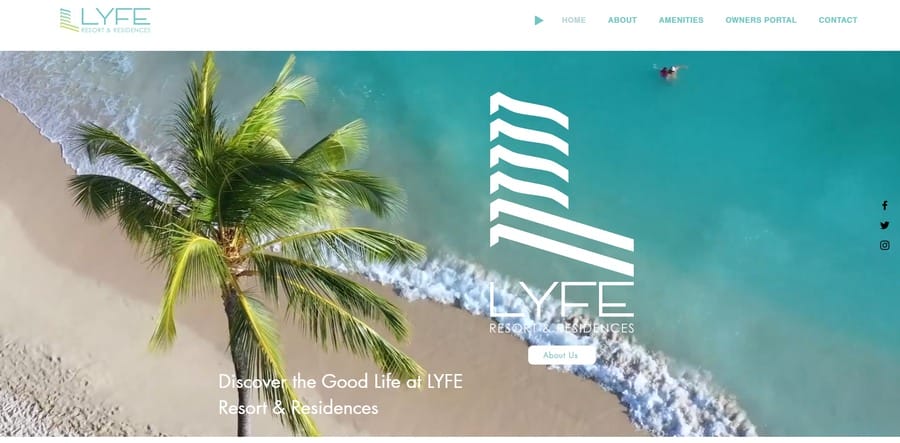
The name was crafted to signal a modern, dynamic lifestyle and the visual identity from the logo to detailed brand guidelines balanced sophistication with approachability.
This foundation positioned Lyfe distinctively within its competitive category, ensuring consistency across every touchpoint and creating a recognizable identity that reflects its beachfront spirit.
Hotel Rebranding Tips
Even the strongest hotel brands eventually need a refresh. Guest expectations change, competitors introduce new concepts and visuals that once felt modern can quickly feel outdated.
A thoughtful hotel rebranding strategy ensures your property stays relevant and attractive while protecting the loyalty you’ve already built.
Signs You Need To Rebrand
While a rebrand isn’t always necessary, you may need to consider it if you see the following signs:
- Outdated perception: Guest surveys or reviews suggest your brand feels tired or inconsistent with modern hospitality standards.
- Losing ground to competitors: Rivals are capturing younger travelers, corporate groups or luxury segments you want to attract.
- Market expansion: Entering new regions or adding new property types requires a broader, more flexible identity.
- Mismatch between promise and reality: If your visuals and messaging don’t reflect the actual guest experience, expectations break down.
- Major ownership or positioning changes: Mergers, acquisitions or repositioning (e.g., shifting from midscale to upscale) often demand a brand reset.
Hotel Rebranding Tips For Success
Once you’ve determined that a rebrand is the smart move, use the steps below to make the most out of your transition:
- Audit before you act: Conduct a brand audit that reviews guest feedback, online reputation, competitor positioning, and staff alignment. This helps you see what to preserve and what to evolve.
- Define the new brand promise: Your unique value proposition should be updated to reflect guest needs today — whether that’s wellness, sustainability, luxury, or digital convenience. Make it specific and measurable.
- Phase the rollout: Sudden changes can confuse loyal guests. Start with digital channels (website, email, social) before updating on-property visuals. Maintain continuity while signaling progress.
- Train and align staff: A rebrand succeeds when employees embody the new standards. Host training sessions, update scripts, and give staff tools to live the brand daily.
- Communicate openly with guests: Don’t hide the transition, but explain why you’ve rebranded. Position it as a commitment to better service and enhanced experiences. Transparency builds trust during change.
For instance, when the Sheraton undertook its global rebrand, it moved away from an outdated corporate image to one centered around community and productivity.
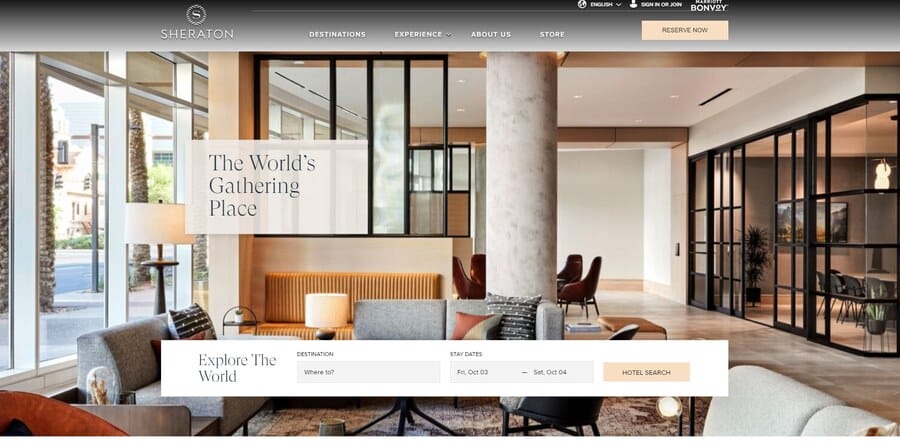
Lobby redesigns introduced co-working spaces, while marketing emphasized modern social connections.
This showed how aligning visuals, experiences and messaging can reposition a legacy brand for the future.
Common Hotel Branding Mistakes To Avoid
Brands lose momentum when inconsistencies or missteps weaken the story they want guests to remember.
The following mistakes are among the most common and each one can dilute identity, erode trust and make it harder to stand out in a competitive market:
- Inconsistent messaging: When different channels or teams present the brand in conflicting ways, guests lose clarity about what the hotel represents. Consistency builds recognition and trust, while inconsistency creates confusion.
- Over-promising experiences: Setting expectations higher than what the property can realistically deliver often results in disappointment. Guests remember unmet promises more than marketing campaigns, which can harm long-term loyalty.
- Neglecting digital touchpoints: A brand is judged as much online as it is on property. Ignoring websites, apps or social media weakens the experience and undermines the investments made in physical branding.
- Copycat branding: Hotels that mimic competitors rather than defining their own identity risk fading into the background. Distinctiveness is what creates memory and pricing power, while imitation makes a brand forgettable.
- Ignoring rebranding needs: A stale brand identity signals stagnation. Timely updates show adaptability.
- Weak hotel brand standards: If service and staff interactions don’t align with your brand, loyalty disappears.
Develop Your Hotel Branding Strategy With Digital Silk
Effective hotel branding comes to life through experiences, touchpoints and strategies that consistently reinforce the core identity.
Every interaction, from the way partnerships are designed to how performance is measured, carries the potential to strengthen or weaken a brand’s place in the market.
Digital Silk creates tailored hotel branding strategies that help properties generate leads in competitive markets, build lasting trust with guests and unlock measurable growth.
As a trusted branding agency, our services include:
- Branding for hotels
- Complete Branding Solutions
- Rebranding services
- Logo and brand design
- Custom web design
- Digital marketing
Ready to create a memorable and impactful hotel branding strategy?
Contact our team, call us at (800) 206-9413 or fill in the Request a Quote form below to schedule a consultation.
"*" indicates required fields


